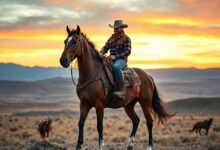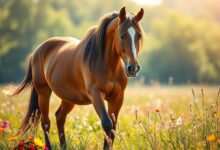Discover the Majestic Big Horse Breeds
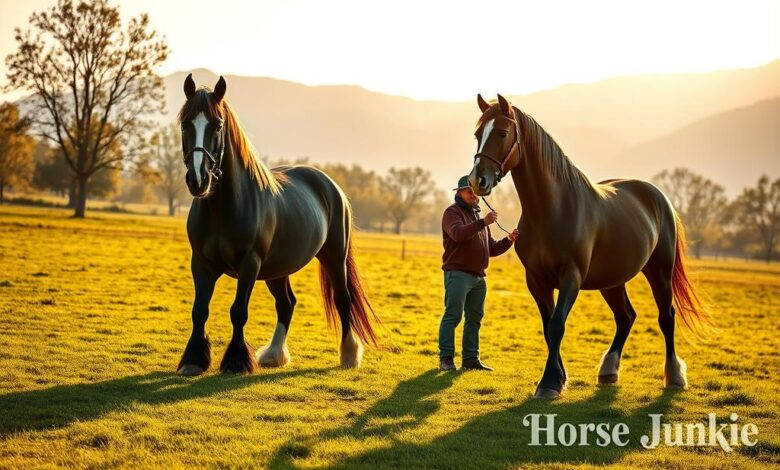
Ever wondered why some horses stand out, towering above others? Big horse breeds are not just big; they have unique traits and a rich history. From the Shire to the Clydesdale, these giants have fascinating stories and pride.
In this article, we’ll explore what makes these horses special. We’ll look at their characteristics, care needs, and cultural value.
Key Takeaways
- The largest horse breeds can exceed heights of 18 hands and weigh up to 2,600 pounds.
- Clydesdales and Percherons are among the most popular big horse breeds in the U.S.
- Big horses often have crucial roles in agriculture and competitive riding.
- Understanding their care and training needs is key to successful ownership.
- Myths surrounding big horse breeds often misrepresent their temperament and handling.
What Defines Big Horse Breeds?
It’s key to know what makes big horse breeds stand out. These horses are easy to spot because of their height and weight. They are truly magnificent.
Characteristics of Large Horses
Looking at the biggest horse breeds, we see some big traits. They can be between 15 to over 19 hands tall. This makes them very noticeable.
The Shire horse is the largest breed. It can weigh over 2,000 pounds. Some Shires can even reach 19 hands tall and weigh almost 3,000 pounds. The Mammoth, a Shire, was 21.2 hands tall and weighed 3,300 pounds.
Common Traits Among Breeds
Big horse breeds share some common traits. They have a strong body and are often calm. This makes them good for many tasks.
They also have feathering on their lower legs, which looks nice. Clydesdales and Percherons are also among the tallest, ranging from 16 to 18 hands.
Differences from Average Horse Breeds
Big horse breeds are different from average ones. They have a muscular build and need more energy. This shows why it’s important to know how to care for them.
Popular Big Horse Breeds in the U.S.
In the United States, a few big horse breeds stand out. These breeds are loved by many and are known for their special traits. They play important roles in farming and culture.
Clydesdales: The Gentle Giants
Clydesdales are known for their strength and grace. They grow to be 16 to 18 hands tall. Their bay coat and white markings make them easy to spot.
They are famous for being part of the Budweiser beer team. Clydesdales are calm and big, making them great for many jobs.
Percherons: Strength and Versatility
Percherons are also among the top big horse breeds. They can be 16 to 18 hands tall and weigh up to 2,600 pounds. These horses are strong and can do many tasks.
They are good for farming, hauling, and even riding. Percherons are known for being gentle and easy to work with.
Shire Horses: History and Heritage
Shire horses are known for their tall stature. They can be 16 to 18 hands tall, sometimes even taller. These horses have a long history in farming and transportation.
They were crucial during the industrial revolution. Shire horses are strong and calm, showing their noble heritage. They are loved as companions in work and play.
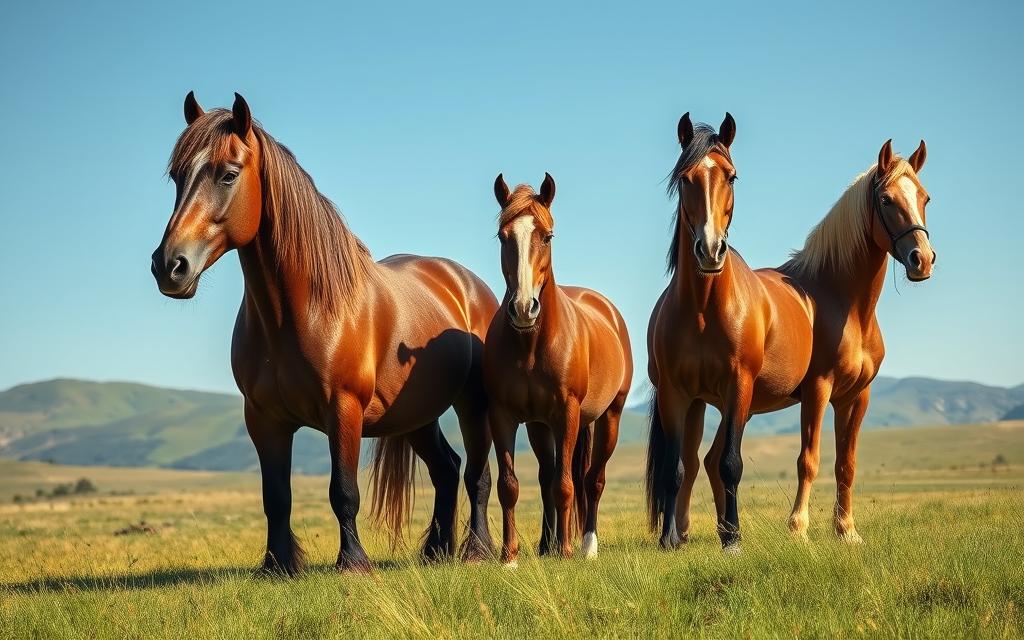
The Benefits of Owning a Large Horse
Owning a large horse can greatly improve our lives and theirs. These animals are not just big; they are also very useful. They meet our different needs and interests.
Ideal for Heavy Work and Drafting
Big horse breeds are perfect for hard work because of their strength and endurance. They are great for tasks like:
- Farming and plowing
- Logging and transportation
- Carrying or pulling heavy loads
They have a lot of power, making them great for tough jobs. This helps the horse industry, which supports many jobs in the U.S.
Companionship and Presence
Big horses also make great companions. They form strong bonds with their owners, offering comfort and support. Their calm nature creates a special connection with us.
Being around these majestic creatures is inspiring and rewarding. It offers a unique experience for both enthusiasts and casual owners.
Versatility in Activities
Large horses are great for many activities, from fun rides to sports. We enjoy them in:
- Trail riding adventures
- Equestrian competitions
- Therapeutic programs
This versatility makes our time with them more enjoyable. It also encourages us to try new things in the equestrian world. Choosing big horse breeds opens up a world of experiences that show their true value.
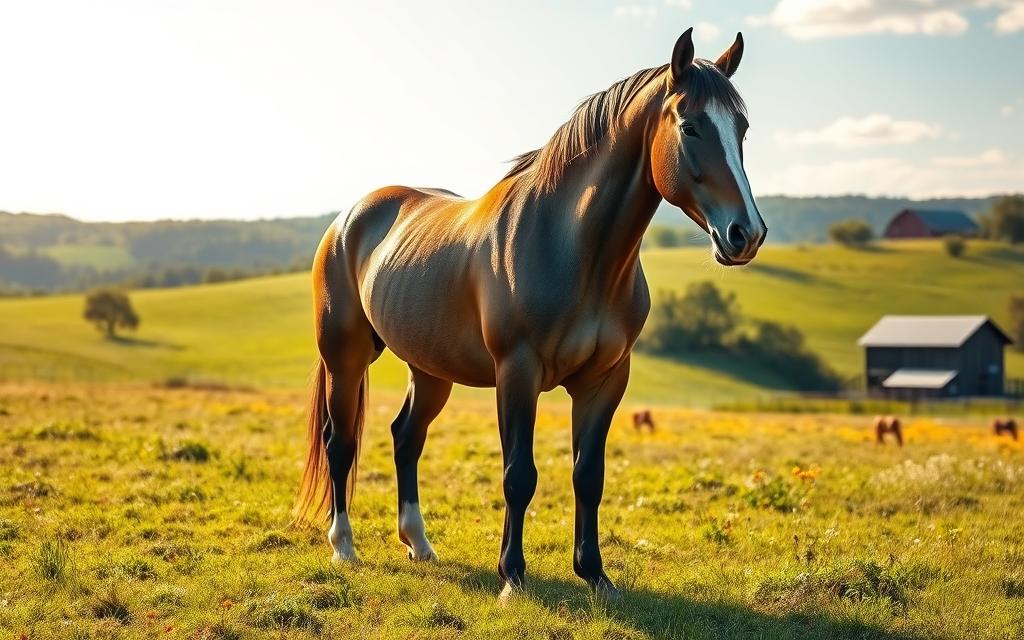
Care Requirements for Big Horse Breeds
Caring for big horse breeds needs special attention to keep them healthy and happy. It’s important to know how to feed them, groom them, and provide the right housing. We aim to give a detailed guide to help future owners understand these key points.
Feeding and Nutrition Needs
Feeding big horses requires careful planning because of their size and energy needs. On average, a horse eats about 20 pounds of food and drinks eight gallons of water each day. They should eat 1-2% of their body weight in roughage daily.
For example, a 1,000-pound horse needs 15-20 pounds of hay every day. It’s best to let them have hay all the time, like they do in the wild. Also, giving grain in small amounts throughout the day helps with digestion and health.
Grooming Essentials
Grooming is key to keeping big horse breeds’ coats and health in check. It involves brushing their coats to remove dirt and doing regular hoof care to avoid problems like thrush or cracks. Regular health checks are also important to catch any signs of discomfort or irritation.
Space and Housing Considerations
Big horse breeds need lots of space for their well-being. They require large exercise areas and stalls that fit their size. A good shelter is also crucial to protect them from extreme weather, like temperatures over 100°F.
Having a well-thought-out barn layout is essential. It should make it easy for the horses to move around and access food and water. This promotes their health and happiness.
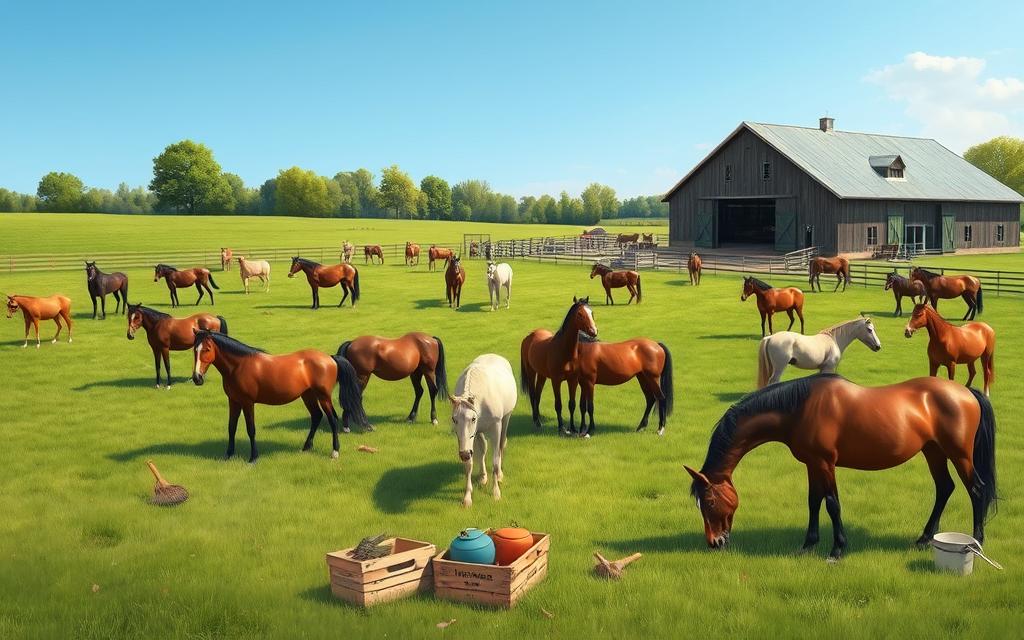
Training Big Horse Breeds: What We Need to Know
Learning how to train big horse breeds is key for their success and safety. Starting training early helps them learn good behavior and how to respond. Using the right training methods makes our interactions smoother and strengthens our bond with these magnificent animals.
Importance of Early Training
Starting training early lays the groundwork for their future behavior. We create a safe space for large horses to learn important commands and social skills. Early training helps avoid future challenges by making them more comfortable with humans from a young age.
Techniques for Handling Large Horses
Dealing with large horses needs special techniques to keep everyone safe. Key methods include:
- Gentleness: A soft approach helps build trust and respect.
- Patience: Large horses need more time to understand, so staying calm is crucial.
- Consistent Communication: Clear signals help them learn what’s expected, making training better.
Using these techniques makes handling large horses easier, leading to a more obedient and responsive animal.
Common Challenges and Solutions
Training big horse breeds can be tough due to their size and strength. Common problems include:
- Resistance to commands: Their size can make them less willing to follow commands.
- Distracted behavior: They can get easily sidetracked, so focused training areas are needed.
- Physical dominance: Their strength can cause problems if they don’t respect human authority.
To solve these issues, we can use a structured training plan, positive reinforcement, and calm environments. With effort, we can overcome these challenges and enjoy a rewarding partnership with these horses.
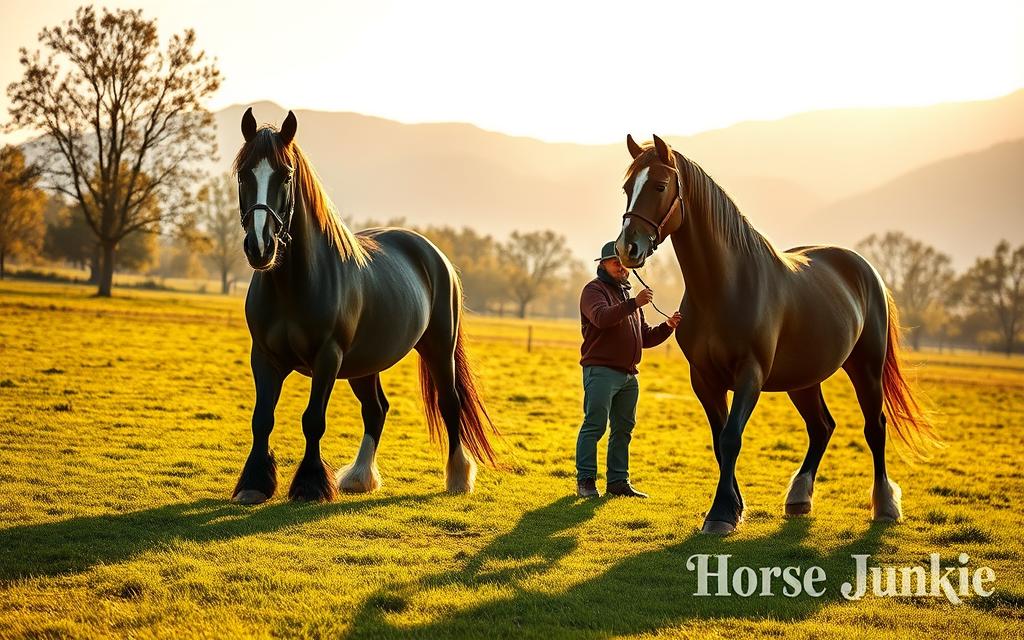
The Role of Big Horse Breeds in Agriculture
Big horse breeds have been crucial in agriculture for centuries. Their strength and ability to do draft work are key. They help with tasks like plowing fields and moving goods on farms.
Draft Work and Farm Use
Big horse breeds have a long history of helping on farms. Their size and muscle make them perfect for heavy tasks. Breeds like the Shire and Clydesdale are great for draft work, helping farmers a lot.
Impact on Modern Agriculture
Even with new farming tech, big horse breeds still have a place. Farmers value their help, especially in green farming. Their work fits well with today’s goals of cutting down on carbon.
Success Stories in Farming
Many farms tell stories of how big horse breeds have helped. Small organic farms use Clydesdales and Percherons, showing old ways can work with new ones. This shows how well animal power and new farming methods can go together.
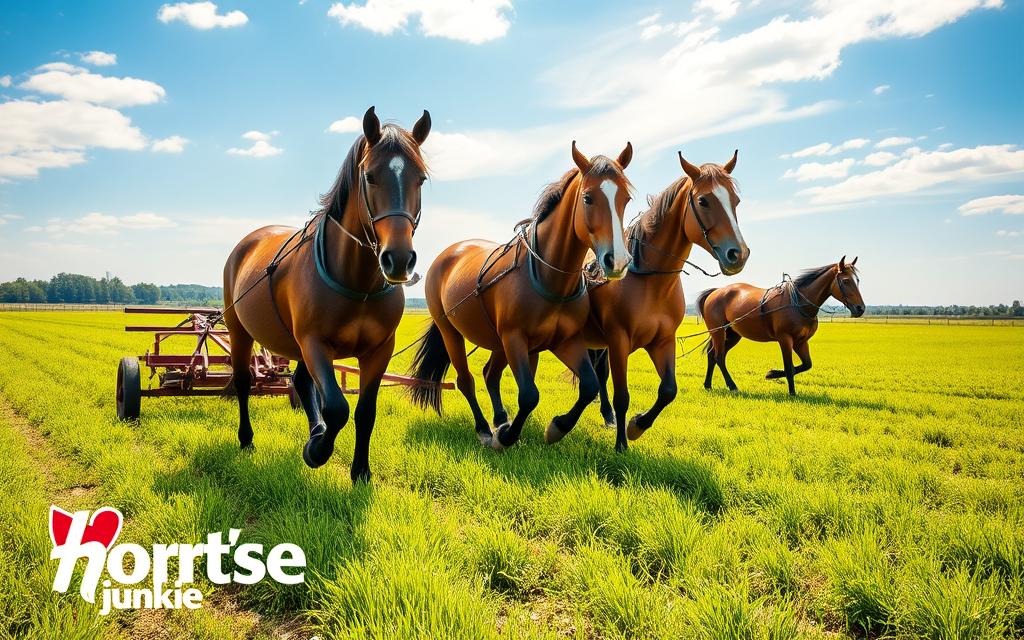
Big Horse Breeds in Competitive Riding
Big horse breeds are known for their power and grace in competitive riding. They excel in events like show jumping and dressage. Their strength and agility make them perfect for these activities.
Show Jumping and Dressage
Show jumping and dressage highlight the skills of big horse breeds. Horses like the Belgian and Percheron do well in these events. Their size helps them jump over big gaps and perform elegant moves.
Driving Competitions
Big horse breeds also shine in driving competitions. Clydesdales and Shire horses show their strength and precision. They can pull carriages or participate in heavy pulling events with ease.
Challenges in Competition
Big horse breeds face challenges in competitive riding. Their size might limit their agility compared to smaller breeds. It’s also important to find riders who match their weight. The rider should weigh at least one-seventh of the horse’s total weight for best performance and safety.
Training and care are key to overcoming these challenges. With the right approach, these horses can excel in the competitive arena.
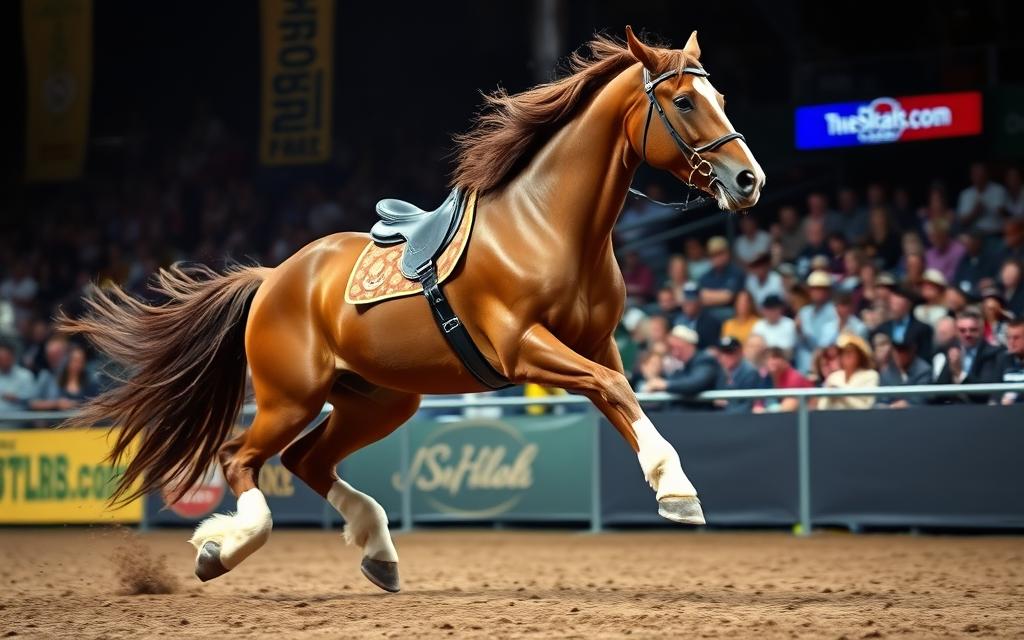
Understanding the Temperament of Large Horses
The temperament of big horse breeds greatly affects how we manage and interact with them. Knowing their typical traits can make our time with them better. These horses are often calm and gentle, perfect for many roles in our lives. We’ll look at their social behaviors and how to manage their temperament during training.
Typical Temperament Traits
Big horse breeds, like Shires and Percherons, are usually calm and gentle. Their nature makes them great for farm work and as companions. Key traits include:
- Gentleness: These horses are patient and tolerant, even with new handlers.
- Calmness: They stay calm in different situations.
- Intelligence: They learn quickly and adapt well to new tasks.
Social Behaviors of Big Breeds
The social behaviors of large horses show how they interact. They form strong bonds with humans and other horses, creating a peaceful environment. Observations show:
- They love being in groups and thrive with their herd.
- They are curious and affectionate with humans.
- They may have a social hierarchy in their group, affecting their behavior.
Managing Temperament in Training
Effective training is key for managing the temperament of large horse breeds. Knowing their personality helps us tailor training to create a positive learning space. Recommended strategies include:
- Building trust through consistent handling and gentle cues.
- Using positive reinforcement to encourage good behavior and build confidence.
- Being patient and flexible, as each horse responds differently to training.
By understanding the temperament of big horse breeds, we can create a rewarding experience. This experience enhances our connection and ensures their happiness. Knowing their social behaviors and using effective training strategies leads to a fulfilling partnership.
Myths and Misconceptions About Big Horse Breeds
Exploring big horse breeds, we find many myths that lead to misconceptions. It’s key to clear up these misunderstandings, especially about size and temperament. These myths shape how we see and interact with these amazing animals.
Busted Myths: Size vs. Temperament
Many think big horses are aggressive because of their size. But, many big horse breeds are actually calm and gentle. They are often called “gentle giants.” Their behavior depends on their environment, training, and personality, not just their size.
By looking at the facts, we see that myths about their temperament can cause fear or hesitation. This is not fair to these magnificent creatures.
Common Misunderstandings
- Some believe big horses need more care than smaller ones. But, care needs really depend on the horse’s personality and health, not just size.
- Another myth is that large horses can’t be versatile. But, many big breeds do well in different equestrian disciplines and competitions.
- Many think big horses are less agile than smaller ones. But, big horses can show amazing agility in certain tasks.
Facts vs. Fiction
Learning about big horse breeds myths helps us see their amazing traits and abilities. Big horses need special care, but myths about their temperament can stop us from connecting with them. A good environment and training are key to managing their size and temperament.
Knowing the truth about them helps us appreciate these incredible animals more. It also helps ensure their well-being in different situations.
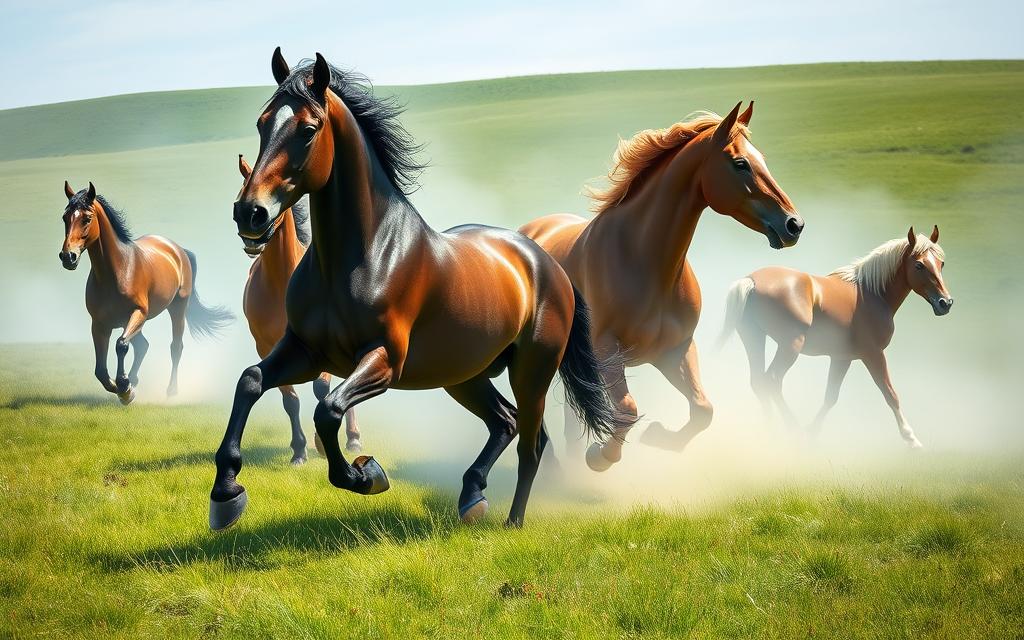
The Future of Big Horse Breeds
Looking ahead, the future of big horse breeds is shaped by new trends in breeding and changing roles in society. We must adapt to keep these majestic animals healthy, useful, and long-lived.
Trends in Breeding
Breeding programs are getting a new lease on life, focusing on keeping large horse breeds unique. Key areas of focus include:
- Health and Temperament: Breeders are now focusing on health and gentle nature.
- Draft Crosses: There’s a growing interest in draft crosses for their strength in equestrian activities.
- Environmental Considerations: Breeding is becoming more eco-friendly, reflecting society’s shift towards sustainability.
Changing Roles in Society
The roles of big horse breeds are expanding, moving beyond traditional uses. They now play roles such as:
- Therapeutic Services: Many large horses help in therapeutic riding programs for those with physical or emotional challenges.
- Recreational Use: There’s a growing interest in pleasure riding and family outings, showing the horse’s versatility and appeal.
- Community Engagement: Events focused on breeding and training bring enthusiasts together, building a sense of community.
Conservation Efforts
Conservation is key to ensuring the long-term survival of big horse breeds. Important efforts include:
- Preservation Programs: Many organizations work to save endangered breeds, raising awareness and support.
- Genetic Diversity Initiatives: Maintaining a diverse gene pool helps prevent health issues and ensures breed resilience.
- Community Engagement: Local clubs and societies play a crucial role in spreading the word about the importance of preserving these animals.
Resources for Learning More About Big Horse Breeds
For those eager to learn more about big horse breeds, there’s a wealth of resources. We can find great books and articles on horse care, training, and history. These resources help us understand horses better and improve our bond with them.
Recommended Books and Articles
Books like “Horses for Everyone” and “The Complete Guide to Horse Care” are full of useful information. They are great for learning about big horse breeds and help us become better horse owners.
Websites and Online Communities
There are many websites and online communities for horse lovers. Sites like Equine.com and the Horse Forums let us connect with others. We can share our experiences and learn from each other, making our journey with horses more rewarding.
Local Clubs and Organizations
Local horse clubs and organizations are also great places to connect. By joining, we can take part in workshops, events, and social gatherings. This way, we can learn more about horses and enjoy the company of like-minded people.
FAQ
What are the largest horse breeds in the world?
What are the typical characteristics of big horse breeds?
How do big horse breeds differ from average horse breeds?
What are some popular big domestic horse breeds in the U.S.?
What benefits do large horse breeds offer?
What care requirements are essential for big horse breeds?
What training strategies work best for big horse breeds?
How do big horse breeds contribute to agriculture?
Are big horse breeds successful in competitive riding?
What is the typical temperament of large horse breeds?
What common myths exist about big horse breeds?
What trends are emerging for big horse breeds?
Where can I find resources to learn more about big horse breeds?
Source Links
- Top 5 Largest Horse Breeds: Discover the Majestic Giants of the Equine World — The Equine Institute
- The 10 Biggest Horses: Giants of the Equine World
- 19 Top Largest Horse Breeds in the World: Equine Giants
- The 10 Biggest Horses: Giants of the Equine World
- A guide to different horse breeds
- The 10 Biggest Horses: Giants of the Equine World
- Get to Know the Most Popular Breeds and Types of Horses
- Economic impact of the horse industry
- Buying Your First Horse
- Costs and Considerations of Caring For Your Horse – DC Structures
- Horse care guidelines
- Low Maintenance/Durable Breeds/Types of Horses?
- Largest Horse Breed Holds World Record for Over 175 Years
- The 10 Biggest Horses: Giants of the Equine World
- Largest Horse Breeds | Strathorn Farm
- The 10 Biggest Horses: Giants of the Equine World
- Heavyweight Champs: 5 Best Horses for Larger Riders – Horse Rookie
- Hot, warm, and cold blooded – understanding horse types
- Horse Breeds: Identifying Ponies, Light Horses and Heavy Ones
- Myth Busters
- Rural Heritage – Front Porch
- Looking for a Horse? Consider Draft Horse Breeds
- How Many Breeds of Horses Are There? Find Out Now!
- Shire Horse Breed – Shire Horse Price & Shire Horse For Sale
- Horse Discovery – Breeds by Type



